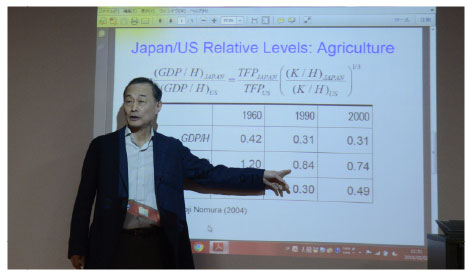News Archives
2016.2.3
GRIPS Professor Hayashi Fumio presents Lunch Time Seminar on Japan’s prewar and postwar economic development.
The 2016 lunch time seminar series kicked off at GRIPS on Wednesday February 3rd with eminent Professor Fumio Hayashi presenting on Japan’s prewar and postwar economic development.
Hayashi outlined the history of Japan’s economic growth stating that there have been three distinct phases since the late 19th century. The first he claims was a long period of relative stagnation pre-war. Following the war, Japan experienced a phase of rapid growth often referred to as the ‘Japanese miracle’. The third phase is the lost decades since 1990 – another period of stagnation arguably now into a 3rd such decade.
It was the pre-war stagnation phase that Hayashi mainly focused on, suggesting it was cultural, predetermined roles within the family unit that ultimately held Japan back in the early years and that in fact, the 2nd phase of high growth could have occurred much earlier.
In sharp contrast to its booming postwar growth, the Japanese economy stagnated for a long time before World War II: pre-war Japanese real GNP per worker remained about 30% of that of the U.S., at least since 1885. Hayashi identifies what he calls a ‘barrier’ as the main cause of the prewar stagnation that forced the number of persons employed in agriculture to be constant at about 14 million throughout the prewar period. Showing a two-sector growth model, Hayashi asserted that were it not for the barrier, Japan’s prewar GNP per worker would have been about 40% higher than it actually was.
So what was this barrier?
Hayashi refers to it as a ‘Sectoral Misallocation Hypothesis’ – essentially a labor barrier which acted as an impediment to the economy’s overall production efficiency. It existed because of cultural and societal norms in that the head of the farm household had to be succeeded by the eldest son upon his death or retirement to carry on the same duties in a world where there was little social mobility or migration. Hayashi backed up his argument with a graph depicting pre-war employment in agriculture at a constant of 14 million persons in prewar Japan. In essence, he claims it took Japan 50 years to reduce agricultural employment share from 60% to 40% whereas most other developing and developed countries experienced a faster decline. Hence this barrier in prewar Japan prevented people from moving out of agriculture.
Article GRIPS Public Relations







